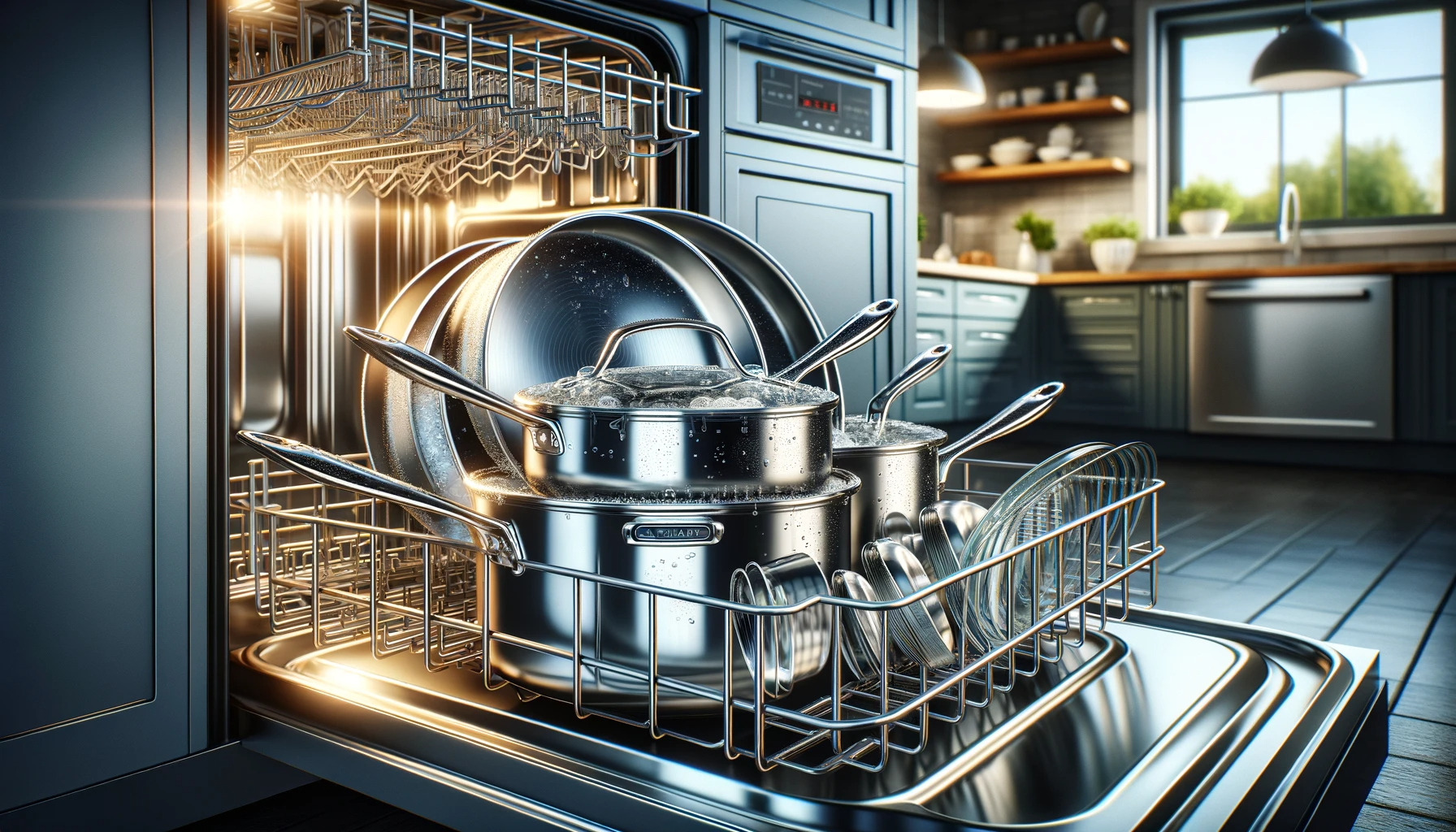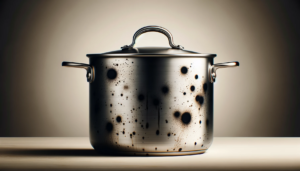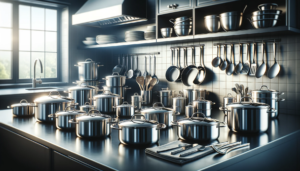Does running your All-Clad or KitchenAid stainless steel cookware through the dishwasher gradually ruin it with rust and scratches?
Stainless steel’s corrosion-resistant properties derive from a chromium oxide barrier protecting the underlying steel alloy.
This means quality stainless steel cookware can withstand regular dishwasher cleaning without damage.
But several factors impact long-term safety and longevity.
Let’s dive into proper grades to buy, maintenance tips and signs poorer stainless isn’t dishwasher safe forever.
Is Stainless Steel Cookware Dishwasher Safe?
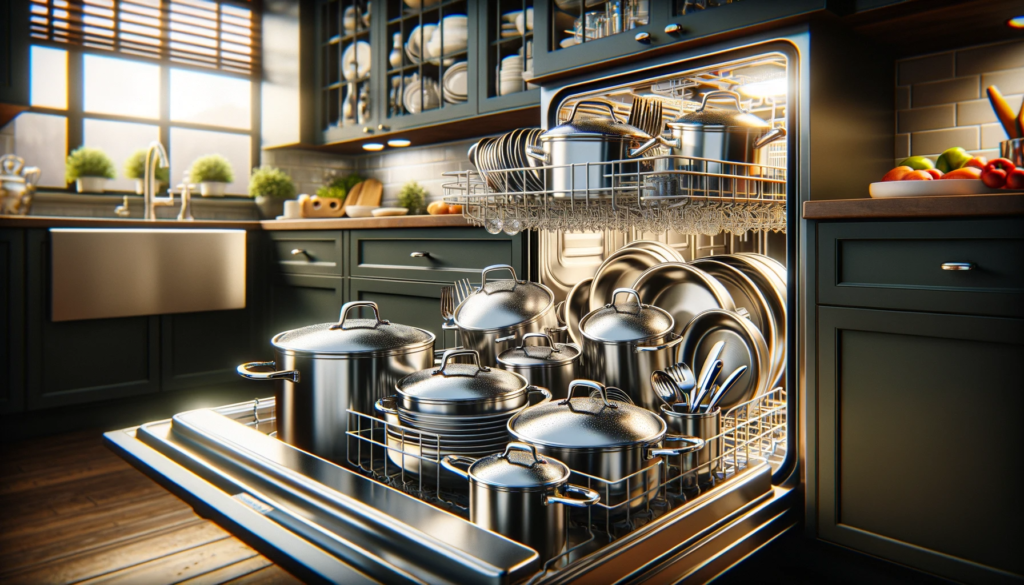
Yes, most stainless steel pots, pans, and other cookware are dishwasher safe.
The stainless steel material is durable enough to withstand regular hot water, detergent chemicals, and heat drying cycles in a typical dishwasher machine.
Grades 304 and 316 stainless steel, common in residential kitchenware, contain chromium oxide that provides a protective barrier against corrosion, stains, and rust in the dishwasher environment.
As long as the stainless steel is sufficiently thick and high quality from a reputable brand, household stainless steel cookware will resist damage from repeated automatic dishwasher cleaning.
However, factors like dishwasher condition, cleaning methods, and lower grade stainless quality can impact long term appearance and longevity.
With proper use and care per manufacturer guidelines, quality stainless cookware will maintain effectiveness and shine for many years of dishwasher use.
What is Stainless Steel Cookware?
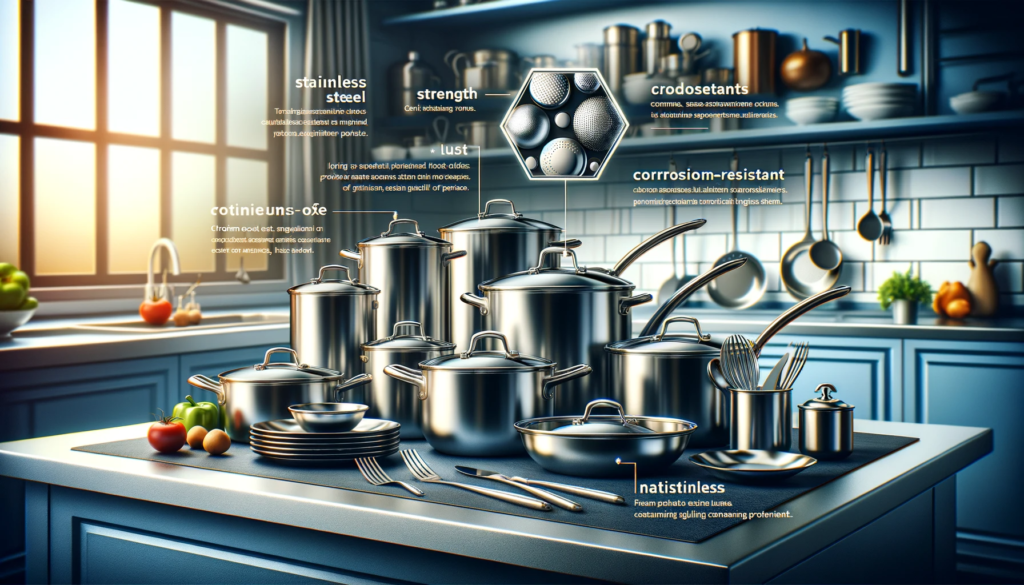
Stainless steel is a versatile, strong and lustrous metal alloy used to construct high quality cookware.
It gets its name from having corrosion or “stainless” resistance properties.
Stainless steel alloys always contain a minimum of 10.5% chromium combined with steel and sometimes other metals like nickel, molybdenum, titanium and copper.
The chromium generates a microscopic surface layer of chrome oxide when exposed to oxygen.
This invisible chromium oxide coating sticks tightly to the steel, acting as a shield against rust and other deterioration.
As long as the coating remains intact, the steel underneath has corrosion protection and stays stainless.
Additional alloying elements like nickel and molybdenum further improve stainless steel’s resistance to surface damage from heat, water and chemicals.
When stainless steel is fabricated into pots, pans and other cooking vessels, these natural anti-corrosive abilities make it highly durable and long-lasting through years of kitchen use.
The material’s strength means cookware resists denting and retains its shape despite rough handling.
Stainless steel’s smooth, glossy surface also makes cookware simple to clean by hand or machine after cooking tasks are complete.
Common “austenitic” stainless steel grades utilized to produce kitchen cookware include grades 304 (18/8) and 316.
The numbers 18/8 reference the fact that 304 contains about 18% chromium and 8% nickel by weight.
Nickel better enables chromium’s rust protection abilities, so having sufficient nickel is also important.
316 boosts durability even further with addition of 2-3% molybdenum and more nickel.
This grade resists pitting and corrosion especially well in harsh, wet salt air environments like coastal areas.
Premium restaurant cookware may use specialized proprietary stainless steel blends personalized for increased performance, but grade 316 satisfies most residential usage.
Is Stainless Steel Dishwasher Safe?
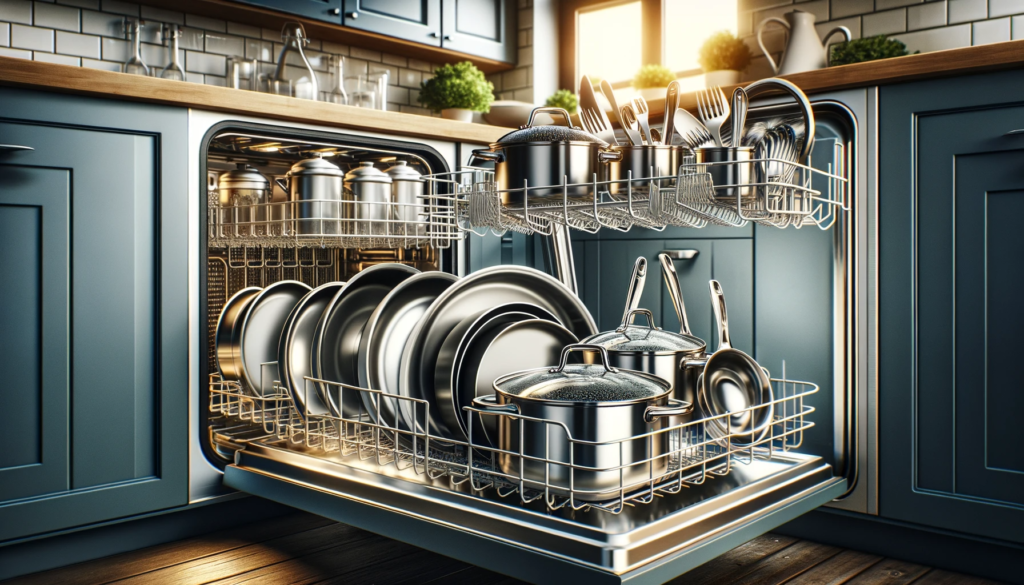
Yes, stainless steel pots, pans and other cookware are generally considered safe for automatic dishwasher cleaning.
The stainless steel material itself can easily withstand the hot water, drying heat cycles, moisture and dishwasher detergent chemicals utilized in home appliance dishwashers.
Stainless steel’s corrosion-resistant properties derive from the naturally forming protective chromium oxide barrier layer shielding the base metal alloy underneath.
This means stainless steel resists the rusting, etching, cracking and other damage dishwasher conditions could potentially cause on surfaces not designed for compatibility.
Assuming appropriately thick, high quality stainless steel cookware containing sufficient chromium, nickel and optionally molybdenum, the metal itself should remain intact for years of repeat dishwasher use with no issues.
However, variables like pre-existing small cracks or imperfections, poorly maintained dishwashers depositing rust residues internally, and inadequate pre-washing of extremely stuck-on grime before loading can impact long term performance and aesthetics over time.
Paying attention to grade of stainless used, dishwasher condition itself, pre-treatment methods and inspection after cleaning helps ensure stainless steel pans thrive in dishwasher conditions without premature wear or tear.
Factors that Affect Dishwasher Safety
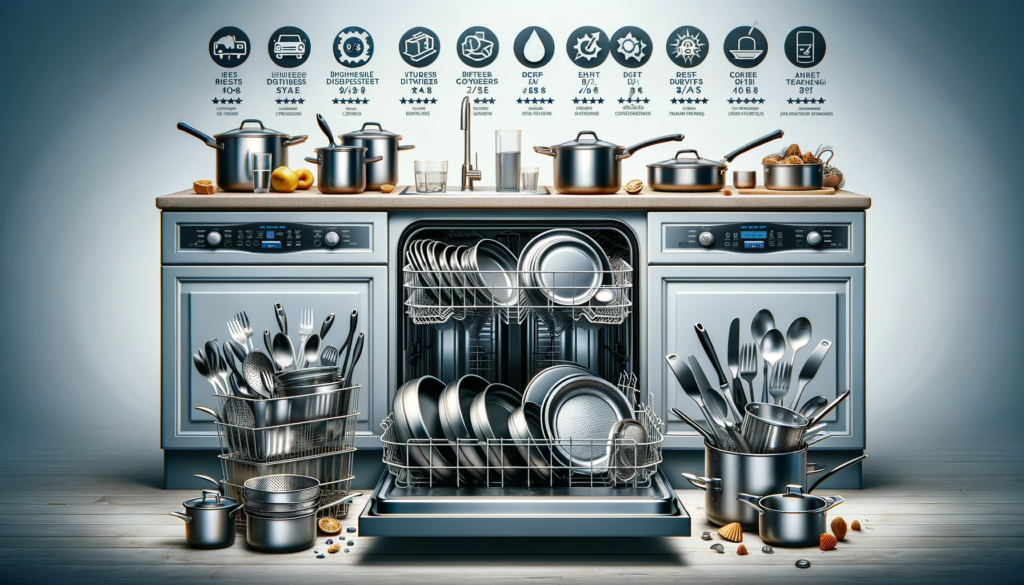
Quality and Grade of Stainless Steel
One contributor impacting corrosion resistance for stainless steel cookware in dishwasher environments includes metallurgical factors like steel grade quality, alloy purity and surface condition.
Not all stainless steel has equal levels of rust protection and longevity despite the name.
Less expensive cookware may utilize thinner steel with marginally adequate chromium or nickel to still qualify as stainless.
But lower alloy ratios mean less corrosion resistance compared to quality 18/10 or 18/8 stainless from reputable brands.
Lower grades also frequently lack supplemental metals like protective molybdenum to further strengthen the invisible chromium oxide barrier.
Over hundreds of hot, damp and chemically harsh dishwasher cycles, lower tier stainless steel eventually allows creeping pinhole rust penetration leading to discoloration and pitting.
Insufficient nickel causes the stainless surface layer protecting the carbon steel underneath to break down faster as well.
Higher grades like 316 resist this degradation substantially better.
But no stainless resists dishwasher wear forever, so buyer beware when purchasing very inexpensive stainless advertized as dishwasher safe if expecting decades of reliable service.
Checking thickness with magnets before buying helps confirm adequate stainless steel purity.
Condition of Dishwasher
While quality stainless steel is designed to resist moisture, heat and detergents, a compromised or faulty dishwasher machine itself can undermine performance and longevity of cookware.
Old dishwashers containing rust deposits internally either from prior loads or failing components will tend to transfer some of those iron particles back onto stainless steel items cleaned inside.
Even the highest grade stainless isn’t immune from picking up extraneous rust residing in the dishwasher chamber rather than rust originating from the steel itself.
Hard water is another factor if not mitigated, producing eventual surface cloudiness or etching along with potentially stubborn leftover mineral stains on stainless cookware washed repeatedly.
Installation of whole home water softeners helps reduces mineral buildup.
Avoiding low cost off-brand or highly caustic dishwasher detergents is wise as well, as harsher formulations accelerate cosmetic damage through micro abrasion effects over time, damaging the protective oxides.
For optimal stainless steel cookware lifespans, ensure your cleaning appliance itself remains rust-free, mineral deposit free and utilizes moderate detergent chemistry designed for compatibility.
Cleaning Method
How stainless steel cookware is prepped before loading into the dishwasher also plays a substantial role.
While stainless steel itself withstands high heat, the sugars, proteins and food residues left stuck on hot surfaces get exponentially harder to remove once baked on and carbonized.
Burned on drips turn into textured char requiring extreme chemical or abrasive force to lift, rather than simple rinsing while still fresh and warm.
The combination of chemically aggressive dishwasher detergents working for prolonged cycles to dislodge stubborn grime wears down stainless steel surfaces faster through micro etching and pitting effects.
For best results, make a habit to thoroughly yet gently rinse cookware immediately after cooking tasks are complete.
Soft sponges, warm water and a bit of mild soap while food residues are still fresh and moist allow quick release without needing abrasives like steel wool pads later.
If more difficult burned on stains occur accidentally, use wooden or nylon scrapers gently rather than metal wool prior to dishwasher loading to lift the worst buildup.
This saves the dishwasher itself from extra strain trying to scour cooked on grime off stainless surfaces affected.
Letting stainless cookware soak briefly in warm water before washing also allows proteins to hydrate and loosen their grip for easier removal.
Then the dishwasher itself has minimal residues to finish eliminating using regular cycles.
Steps to Safely Clean Stainless Steel Cookware in Dishwasher

When preparing to clean stainless steel pots, pans and kitchen tools in the automatic dishwasher, it is wise to acquire quality cookware to start.
Seek out reputable kitchenware brands that use grades 304/18-10 or 316 stainless steel with substantial heft and thickness.
Checking magnetism on the bottom of pans can confirm if adequate stainless steel purity is present before purchasing.
It is also important to rinse off food residues after cooking rather than allowing soils and grime to dry on the cookware surfaces.
Gently rinse pans immediately after use while still warm, using soft sponges or cloths, to prevent food particles from sticking firmly.
Inspecting the condition of the dishwasher itself is another recommended tip.
Ensure there is no internal rust buildup or damaged parts inside the appliance chamber or around the spray arms.
Clean out any debris as well, like leftover heavy duty scrub pads, that could mark up steel surfaces during washing cycles.
When it comes to detergents, avoid harsh or caustic industrial alkaline cleaners that can etch metal over time with prolonged use.
Instead check the dishwasher manual for the appliance manufacturer’s recommended gentle formulations.
Installing a whole home water softener can also be beneficial if dealing with hard water, which leaves bothersome surface films and spots on stainless steel requiring extra re-washing by hand later to remove deposits.
Strategically loading pieces in the racks fully exposed to spray arms, rather than nested or tilted at angles limiting water flow access, allows for thorough cleaning too.
Finally, after unloading a finished wash cycle, inspect cookware closely for any corrosion spots or clinging detergent residue that failed to rinse away.
If present, spot clean affected areas gently by hand using undiluted white vinegar.
Signs Your Stainless Steel Cookware Isn’t Dishwasher Safe
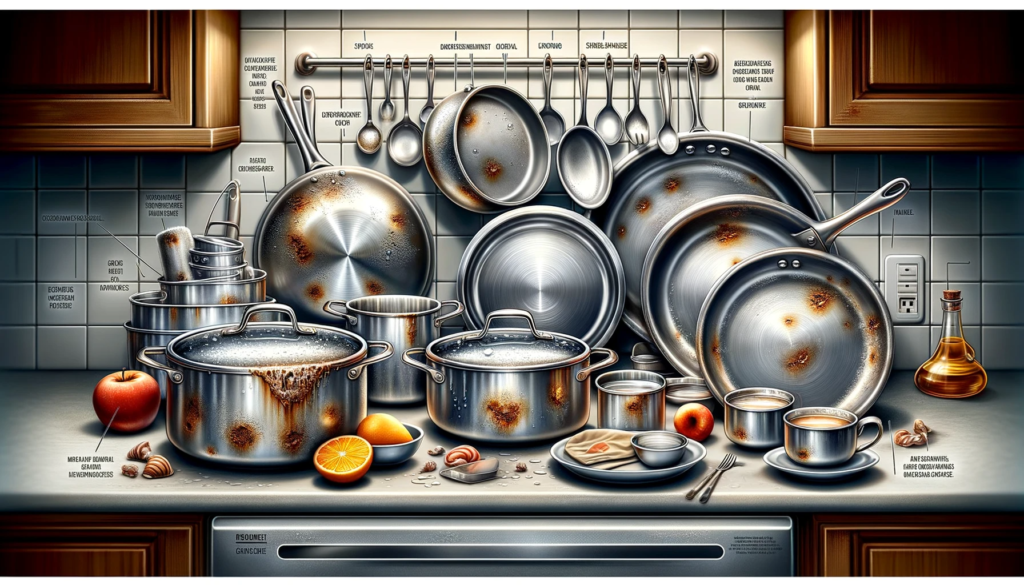
With prolonged, repeated dishwasher use over months and years, lower grade or compromised stainless steel cookware eventually shows warning signs it may no longer be suitable for harsh machine washing methods without risking damage.
These red flags include:
Rust Spots Forming, Flaking Metal
Pinhole dots of corrosion first penetrating the protective oxide layer manifest as small but visible rust spots on stainless steel cookware surface.
These arise most commonly at joints, crevices, edges and ends rather than flat expanses.
Without mitigation, expanding ferrous corrosion underneath causes the spots to multiply and connect in lacy patterns.
Eventually, surface pitting flakes away taking the exterior chromium layer completely with it.
At this stage, bare exposed carbon steel rapidly corrodes without stainless barrier shielding.
Cloudiness, Etching, Pitting on Surface
Beyond rust corrosion, caustic dishwasher detergents themselves slowly damage stainless steel too through chemical interaction effects producing exterior dulling.
The continuous hot water and strong alkaline soaps combine to microscopically etch the original mirror glossy cookware surface.
Gradually, these subtler insults accumulate into patchy cloudiness first before isolated pitting appears.
Though purely cosmetic rather than structural initially, surface degradation leaves cookware looking old and worn relatively quickly.
Discoloration or Aluminum Showing at Bottom
Quality stainless steel cookware often contains internal aluminum or copper based cores at the bottom to improve heat control properties.
If the stainless steel layer starts significantly breaking down through rust corrosion or chemical etching damage, the darker base metal underneath gets revealed.
This manifests as clearly delineated spots of grey, brown or black discoloration at pan bottoms in particular.
These visual cues signal the fundamental layered construction is failing and coming apart after too many dishwasher cycles attacking microscopic vulnerabilities.
At the very first signs of corrosion freckles, subtle surface etching or inner metal peeking through on stainless steel cookware, pull the pieces from dishwasher rotation.
Hand wash gently instead with non-abrasive formulas to salvage longevity without exacerbating existing flaws.
For cookware showing more prominent splattering rust or big patches of base metal visible, retirement from dishwasher methods is likely permanent.
Consider upgrading to thicker, higher grade stainless steel cookware to avoid repeats of cosmetic or actual corrosion damage over time.
Conclusion
In conclusion, most stainless steel pots and pans are durable enough for dishwasher cleaning thanks to protective chromium oxide coatings resisting corrosion.
But lower grades may degrade over time, while pre-washing stuck residues and checking appliance condition preserves appearance and performance.
Investing in quality cookware plus following best practices keeps stainless steel shining safely in the dishwasher for years.
